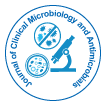
Journal of Clinical Microbiology and Antimicrobials
Open Access
+44-77-2385-9429

+44-77-2385-9429
Six bacterial strains with the capability of degrading textile dyes were isolated from sludge samples and mud lakes. Aeromonas hydrophila was selected and identified because it exhibited the greatest color removal from various dyes. Although A. hydrophila displayed good growth in aerobic or agitation culture (AGI culture), color removal was the best in anoxic or anaerobic culture (ANA culture). For color removal, the most suitable pH and temperature were pH 5.5-10.0 and 20-35 degrees C under anoxic culture (ANO culture). More than 90% of RED RBN was reduced in color within 8 days at a dye concentration of 3,000 mg l(-1). This strain could also decolorize the media containing a mixture of dyes within 2 days of incubation. Nitrogen sources such as yeast extract or peptone could enhance strongly the decolorization efficiency. In contrast to a nitrogen source, glucose inhibited decolorization activity because the consumed glucose was converted to organic acids that might decrease the pH of the culture medium, thus inhibiting the cell growth and decolorization activity. Decolorization appeared to proceed primarily by biological degradation
Posters & Accepted Abstracts: Journal of Antivirals & Antiretrovirals
Posters & Accepted Abstracts: Virology & Mycology